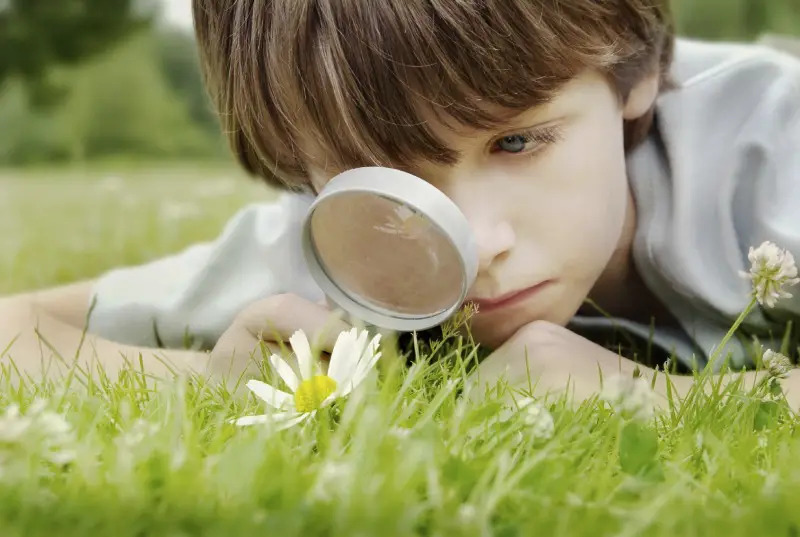Don’t relegate creativity to the art classroom. Encourage your kids to explore, tap into their curiosity, and open themselves to a world of possibilities in every facet of their lives. Our expert tells you how to encourage kids to be creative and curious, and offers activities and exercises to strengthen the creativity muscle.

“Why, why, why?” It’s a constant childhood refrain, and many parents feel relieved when their preschoolers outgrow this urge to question. Actually, the best thing you can do for your child is to help sustain it. Curiosity is linked to creativity, and we know that both decline between the ages of five and eight, bottoming out in pre-adolescence. During the teen years, curiosity is further undermined by the premium placed on ‘right answers’ for standardized testing. Eventually, little remains of a curious child’s natural inclination to question and challenge the status quo.
But that is exactly the capacity most essential to personal, professional, and academic success in today’s rapidly changing world. According to Tony Wagner of the Change Leadership Group at Harvard School of Education, qualities such as curiosity, creativity, and imagination are for today’s kids “what the ‘three R’s’ were for previous generations.” Corporate executives agree. In a 2010 survey, 1,500 CEOs named “creativity” as the most important leadership competency for the future.
How to Spell C-U-R-I-O-S-I-T-Y
Creativity has moved well beyond art classrooms. In any field, it means the ability to explore and respond flexibly to our environment in new and meaningful ways. Art lessons and projects can reinforce creativity, but the best way to teach and develop creative thinking is by making these habits of curiosity part of your child’s life every day.
C: CONNECT CREATIVITY, CURIOSITY, and CARING.
Creativity begins with wondering and questioning. For innovation in any area, asking good questions is as important as finding solutions. Caring—being interested in what we are doing—also stimulates creativity. This link is found in the word curiosity itself: from a Latin root related to ‘interest and care.’
U: USE UNCERTAINTY.
The ability to embrace uncertainty and ambiguity is a key factor for all creativity. This habit values process, not just product. Seeing uncertainty as a creative opportunity enables kids to keep experimenting and exploring possibilities. What matters is creative thinking, not just the end result of something to hang on the fridge.
R: REFLECT, REFINE.
Along with right-brain intuition and imagination, creating anything new involves the rational, evaluating left-brain. What neuroscience calls “mind wandering” connects old information in new ways that trigger creative insights. But making any new idea work also requires that we pause, reflect, and focus on refining it.
I: INVESTIGATE MULTIPLE VIEWPOINTS.
Traditional linear thinking is sometimes limiting, while nonlinear approaches open up our thinking. By investigating different points of view and challenging assumptions, we can: get past familiar or superficial solutions; minimize fear of being wrong (there is no single “right answer” when exploring); find a fresh perspective. If it works, great! If not, even ridiculous angles can lead to surprising solutions we might otherwise have missed.
O: OBSERVE CLOSELY.
Quick observations rely on stereotypes and general impressions. On the other hand, careful observation sharpens awareness, enhances perception and captures more information. Paying close attention—noticing and absorbing details with all senses—increases available raw material for creativity.
S: STICK WITH IT.
Above all, creativity is a process. We need to persist even when tasks or problems are difficult. But knowing when to stop and recharge is also important. Sometimes an impasse can be turned around not by staying relentlessly on it, but by shifting attention to something completely unrelated, then returning to the original task with fresh eyes.
I: IMAGINE.
This is a fundamental habit for creativity: Have fun, play, rearrange, and make it strange! Most ‘new’ ideas just recombine or modify what we already know. Playing around with ordinary connections makes familiar things or ideas appear strange or extraordinary—as if seen for the first time. Imagination, like play, boosts flexible thinking: Existing information (what is) is combined in unfamiliar ways (what if?) and sparks possibilities (what could be). Disrupting routine thinking frees us to see unexpected creative alternatives.
T: TAKE RISKS.
To create is to risk. There is uncertainty about ideas that are different, maybe even wrong. But “mistakes” are necessary to the process as we explore new ways of seeing, thinking, doing, and understanding. Ultimately, fresh insights emerge only if kids feel comfortable with the discomfort of risk-taking.
Y: YOU ARE NOT AN ISLAND.
We live, think, and create in a world that influences us, even as we influence it over time. The cooperative interplay of individual and group experience, intuition, and knowledge expands opportunities for discovery. Collaborating with others sparks ideas in unpredictable ways.
—
These habits of curiosity are not a new skill set, but a playful perspective and the spirit of exploration that all children already have. The natural impulse to know new things enhances lifelong creative thinking, cognitive understanding, and social-emotional skills like independent thinking, self-awareness, and other-awareness (empathy). Creativity encourages children to learn from and transform their world in personally meaningful ways every day.
Want some tips about how to encourage curiosity and creativity in your child? Diane has you covered! Check out these 7 easy tips to inspire your child to be curious and creative.
Diane Rosen is a New York-based artist, writer, and educator who has taught English and Studio Art at secondary and college levels, emphasizing curiosity as a universal driving force in the creative process across disciplines. She earned her M.A. in English Education at Teachers College, Columbia University, and studied painting in Paris on a French Government Fellowship. Rosen’s book, “Bringing Inquiry In: A Curriculum Guide,” was published by SPI Press, Teachers College, in 2010. Visit Diane’s website to learn more.





















